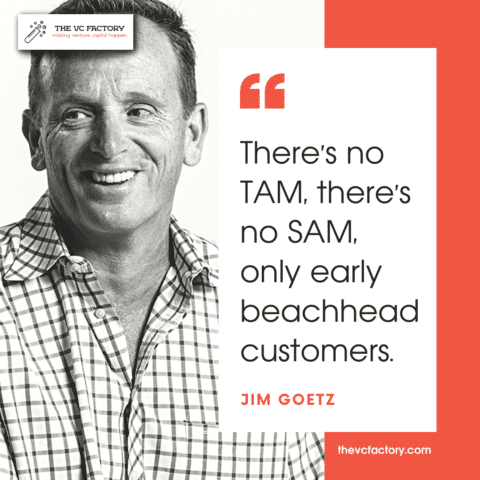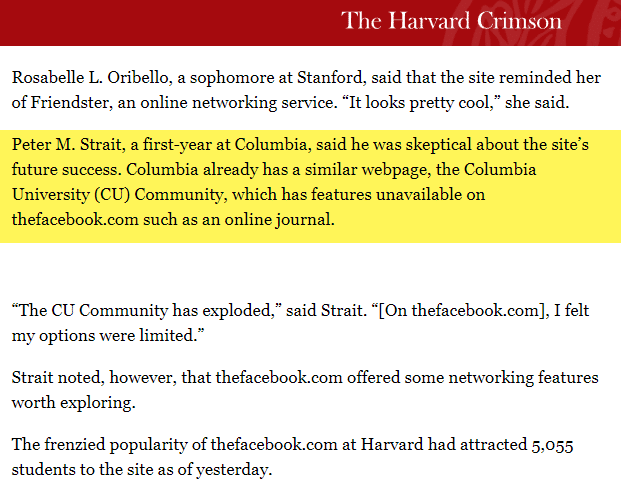“There’s no TAM, there’s no SAM, only early beachhead customers.” – Jim Goetz

Imagine discarding the traditional TAM SAM SOM approach to estimating a startup’s potential. Sounds audacious? Not to Jim Goetz, a legendary Venture Capitalist who’s backed major tech successes over the past two decades. According to Goetz, the key to startup success lies not in large market projections, but in the humble beginnings of identifying early beachhead customers.
In this post, we’ll take a deep dive into this intriguing concept. We’ll demystify how a beachhead strategy functions, contrast it with the established TAM SAM SOM approach, bring it to life with two real-world case studies, and finally, examine how savvy Venture Capitalists wield this framework to pinpoint promising startup investments.
In This Post
Beachhead vs. TAM SAM SOM: Which One Is Better?
Venture Capitalists evaluating a startup’s potential to triage their deal flow focus on three key criteria: the fit with their investment strategy, the Founding team’s quality, and the market’s size. Two commonly discussed approaches are the Beachhead Strategy and the TAM SAM SOM analysis. While they both aim to assess a company’s growth potential, their approaches differ significantly, leading to different implications and uses.
The Origin of the Beachhead Strategy
The term ‘Beachhead Strategy’ finds its roots in a crucial World War II event—the D-Day Normandy landings. In this military strategy, the Allied Forces aimed to secure one beach at a time, gradually establishing a strong position for further expansion into enemy territory. This approach served as the stepping-stone to their victory.
Translating this strategy into business terms, a startup chooses a specific, well-defined market segment—its ‘beachhead’—as its first target. By establishing a solid presence and gaining significant market share within this segment, the startup sets the stage for successful expansion into other market segments.
The Beachhead Strategy relies on finding the beachhead customers that Jim Goetz refers to.
Beachhead Customers Help Startups Win
Just as the secured beach in a military campaign becomes a stronghold facilitating further invasions, the beachhead customers in a startup’s growth strategy form a loyal user base that aids future market penetration.
These are the early adopters who believe in the product, actively use it, and significantly, become the product’s advocates. They provide not only the initial revenue stream but also valuable feedback and credibility, encouraging other potential customers. Their referrals contribute to an organic, cost-effective expansion.
Each successful beachhead market forms a springboard that propels the company into the next market segment, allowing it to grow stronger and larger with each step.
How Beachhead and TAM SAM SOM Differ
The Total Addressable Market (TAM), Serviceable Available Market (SAM), and Serviceable Obtainable Market (SOM) approach is a method traditionally used by entrepreneurs and investors to assess the market potential of a business. It starts with understanding the maximum market demand (TAM), then narrows down to the segment that can be served with the startup’s current capabilities (SAM), and finally, pinpoints the market share that the startup can realistically capture in the short term (SOM).
The key difference lies in the nature of these approaches. The TAM SAM SOM analysis is more of a top-down approach, focusing on existing market sizes to gauge potential. It is particularly useful for startups planning to enter well-defined, existing markets.
In contrast, the Beachhead Strategy is a bottom-up approach that is more suitable for innovative startups creating new markets or disrupting existing ones. This strategy allows startups to focus on winning one market segment at a time, thereby establishing a firm foothold for future expansions. It emphasizes gaining an understanding of the most promising users and achieving product/market fit for each segment.
In essence, while TAM SAM SOM evaluates the size of the prize, the Beachhead Strategy provides a road map on how to win it.
I now delve into two distinct case studies: Facebook and Tesla. They not only illustrate how a Beachhead Strategy works in real-world scenarios but also shed light on its nuances and potential benefits. Facebook and Tesla, two distinct behemoths in their respective industries, have intriguing stories that highlight the power and effectiveness of a well-executed beachhead strategy.
Case Study 1: Facebook Expanding Beyond College Campuses
Facebook provides an excellent example of the Beachhead Strategy in action. During its early stages, Facebook was not the only social networking platform available. It had to compete against big players like MySpace (the market leader) and Friendster (the first mover), and even with other campus-based directories, which had millions of users. Facebook— thefacebook.com, as it was then named— was not even the only digital student directory service. Other prestigious campuses had their own.
Using Harvard As A Beachhead
The Facebook Founding team, led by Mark Zuckerberg, decided to use Harvard, their initial user base, as a beachhead to move to other campuses. In March 2004, Facebook expanded to Stanford, Yale, and Columbia. At the time, Harvard’s student journal, The Crimson, reported that Columbia students doubted Facebook would surpass the local digital student directory, called CU Community.

How did Facebook conquer Columbia and similar colleges with incumbent web directories? They used network effects to grow exponentially from beachhead to beachhead.
Network Effects Accelerate The Beachhead Strategy
The strategy was to leverage network effects to encourage exponential growth. Network effects, often misunderstood as virality, are when the value of a product or service increases as more people use it.
For Facebook, these network effects played out as follows: The more friends a user had on the platform, the better their experience. This incentivized users to invite their friends to join, which, in turn, enhanced the network effects. Facebook used the connections between different campuses to infiltrate new territories. Students at Harvard, for instance, would invite friends from Stanford, Columbia, and Yale to join the platform.
Facebook reached U.S. college campus dominance in just a couple of years by using this beachhead strategy. They then used these beachhead users to dominate the social network industry and reap winner-takes-all benefits.
Using Colleges As Beachheads
Following the initial successful infiltration into educational institutions, Facebook extended its beachhead strategy beyond university campuses and into the mainstream consumer market. With the application of the ‘Rule of 7’, a marketing principle first identified by the film industry in the 1930s, Facebook intensified its growth. This rule posits that consumers need to encounter an advertisement seven times before deciding to purchase a product or service.
Embracing this principle, Facebook teams encouraged their users to send out invites to their friends, betting on the premise that receiving seven such invites within a ten-day span would compel the invitee to create an account. This strategy became the blueprint many social networks subsequently used to grow their user base.
I remember that this is how I got “recruited” into using LinkedIn. Friends I valued for their professional savviness or who were in HR kept sending me invites. This eventually overcame my initial skepticism and led me to create a profile of my own. Do you remember how you started using Facebook or LinkedIn?
We knew we were going to beat MySpace when we had 45 million users. They had 115 million users.
Chamath Palihapitiya
As Facebook started to establish dominance in its initial beachhead, it turned its attention towards MySpace, a well-established competitor at the time. Chamath Palihapitiya, a former Facebook executive and now an influential figure in Venture Capital, recounts how Facebook’s growth strategy gave them an edge over MySpace. Despite MySpace having a considerably larger user base, Facebook’s initial focus on college students, viral marketing tactics, and leverage of the Rule of 7, facilitated its rapid growth.
The comparative user-friendliness of Facebook’s platform, along with its dedicated focus on social networking, gave it an edge over the more generalized MySpace platform. Timely entry into the market also worked in Facebook’s favor, allowing it to secure a substantial share of the burgeoning social networking market.
In essence, Facebook’s beachhead strategy, coupled with its understanding of key marketing principles, enabled them to rapidly grow its user base, surpass competitors, and firmly establish its dominant position in the social networking industry.
Case Study 2: Tesla’s Top-of-the-Market Strategy
Tesla offers another interesting application of the Beachhead Strategy. However, unlike Facebook, Tesla started at the top of the market with their first product—the Roadster sports car, a high-end luxury vehicle.
The high-end sports car market served as Tesla’s initial beachhead. This strategic choice allowed Tesla to establish its brand as a premium and technologically advanced choice in the automobile industry. After securing a strong foothold in the luxury sports car market, Tesla gradually moved into more affordable market segments with the Model S sedan and later, the Model 3.
Telsa only sold 2,450 Roadsters, but it proved that Tesla, an eletric car maker, could win a niche market.
Dave Lee (Source: Youtube)
This approach allowed Tesla to build assets, reduce costs (thanks to economies of scale), and gather critical data to improve its self-driving technology after dominating each beachhead market. Tesla’s approach to the Beachhead Strategy showcases how this approach can work in different industries and how it can be adapted according to the product and the market conditions.
How Venture Capitalists Use The Beachhead Concept To Evaluate Market Potential
The beachhead strategy doesn’t just offer an effective launchpad for startups, it also provides a useful lens for Venture Capitalists seeking to assess a startup’s potential. This section delves into how the beachhead concept influences Investors’ market size evaluations, customer identification, and judgments about the effectiveness of a startup’s approach.
Market Size vs. Market Opportunity
Proponents of the TAM SAM SOM framework argue that it’s an excellent method for gauging a startup’s potential. According to this view, the larger the market a startup is targeting, the greater the potential for the startup to grow and scale. This perspective is notably supported by figures such as Don Valentine—Sequoia Capital’s Founder and Jim Goetz’s boss until his retirement—who emphasized the importance of large markets to ensure the potential for building a billion-dollar revenue company.
However, this approach presents a catch: it requires pointing to an existing market. What about markets that don’t yet exist, or products and services targeting undefined customers? In such scenarios, the beachhead approach appears more effective.
Focusing on the next beachhead segment involves less concern about the ultimate size of the market and more about achieving product/market fit by catering to the most promising users of your product or service.
What investors want to see is not Market Size, but Market Opportunity.
Bill Reichert – Pegasus TECH VENTURES (Source: LINKEDIN)
For Pegasus Tech Ventures’ Bill Reichert, the main problem with the TAM-SAM-SOM approach is that random numbers about the size of an existing market do not automatically translate into a winning market opportunity. Instead of this top-down approach, Founders should “build a bottom-up model of your customer acquisition process and show how you can build a big, profitable business, customer by customer”.
How can VCs evaluate whether the startup has found its beachhead customers, and is not just surfing on a temporary wave of interest?
Identifying Beachhead Customers
The focus of a beachhead strategy should always be on the customer. According to MIT’s Bill Aulet, customers in beachhead markets fulfill three conditions:
- They purchase similar products
- They share similar sales cycles and value expectations.
- They influence other customers through word-of-mouth or high-value references
These customers form the basis of the early adopter group, also known as beachhead customers. By targeting this demographic first, startups ensure their survival by focusing on the paying segment of a larger market, validating their product or service, building momentum, and creating a loyal customer base.
We don’t want the beachhead market to be the biggest possible market, but the lowest hanging fruit that is big enough to allow us to be cashflow positive and establish a position to win additional markets.
Bill Aulet – MIT (source: YouTUBE)
Smart Skin Care, founded by Aulet phD student Pedro Valencia, illustrates how startups find beachhead customers. After extensive research into potential markets for their patented nanoparticle technology, the Smart Skin Care team recognized an opportunity in the sunscreen sector, which was less regulated than medical ones. The sunscreen market, however, proved too vast, leading the startup to focus on the niche of extreme athletes in their thirties who participate in triathlons. They had the interest, need, and financial resources for high-quality sunscreen. This successful targeting of a specific market segment made the introduction of their product into broader markets easier.
Conclusion: tl;dr
The traditional metrics of Total Addressable Market (TAM) and Serviceable Available Market (SAM) are gradually becoming obsolete, especially when they are not used properly. These metrics can be too large, abstract, and even misleading as they do not consider the specific needs of the early adopters. Founders and Investors alike should instead prioritize establishing a foothold in a particular market segment, validating the product or service offering, and creating a loyal customer base.
This is where the beachhead strategy proves invaluable. Startups such as Facebook and Tesla have successfully employed this approach, overcoming the challenges of identifying the right beachhead market, and building a product that resonates with that market. A beachhead strategy encourages startups to concentrate resources on a specific market, build a strong brand reputation, and learn from their customers to improve their products or services. After establishing a cashflow-positive operation, the startup leaps onto another segment of the market.
Here are a few more points to keep in mind when implementing or evaluating a beachhead strategy:
- The beachhead strategy is not a silver bullet. It is just one part of a successful startup strategy. However, it can be a very effective way to get started and build a strong foundation for future growth
- The beachhead market should be carefully selected. It should be a market where there is a clear need for the startup’s product or service, and where the startup can gain a competitive advantage
- The beachhead strategy should be flexible. The startup should be prepared to adjust its strategy as it learns more about the market and as the market changes.
Experienced Venture Capitalists evaluate startups’ implementation of a well-thought-out beachhead strategy, as it can serve as a significant indicator of potential success. By focusing on specific beachhead customers and dominating that market before expanding to others, startups can provide convincing proof of their growth trajectory and ultimate market potential.
Whether you’re an entrepreneur looking for a blueprint to grow your startup, or an Investor searching for the next big thing, remember that the secret may lie not in the broad expanse of the market, but in the focused strategy of establishing a firm foothold—one beachhead at a time.”

2 comments
I’ve been railing against the TAM/SAM/SOM craziness for years …
https://www.linkedin.com/pulse/stop-madness-more-tams-bill-reichert/
Not sure how any thoughtful VC could support the delusional thinking created by the TAM approach.
Thanks Bill, great share, your post made its way into this one 👌
I also added it to our main post on TAM SAM SOM (see at the end), where I also push for a bottom-up approach but within the TAM SAM SOM framework (that many VCs still insist on) > https://thevcfactory.com/tam-sam-som/